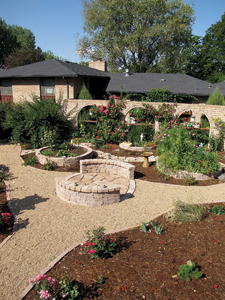Gardening as Therapy
04 Mar 2010
If you think gardening is just a bunch of work, think again and you may discover this pastime’s therapeutic benefits.
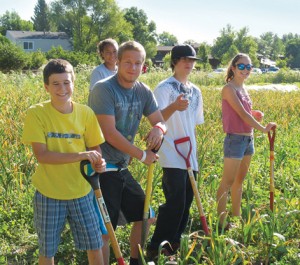 If gardening is more work than pleasure to you, take stock: You may not be doing it right. Planting a flower may not seem like therapy, but countless studies show that gardening promotes healing and a sense of well-being.
Horticultural therapy, which seeks to harness nature’s healing powers through gardening, has gained a stronghold in the nearly 40 years since its inception. Schools like the Horticultural Therapy Institute in Denver now offer degree programs whose graduates work in myriad settings, including rehab centers, hospitals, senior centers, detention facilities and youth agricultural programs, to help participants conquer physical limitations and ease emotional pain.
The results are often miraculous, and in many cases immediate. HTI director Rebecca Haller has seen some amazing things in her 30 years as a master horticultural therapist. “I had a patient once who struggled with chronic pain,” she recounts. “During the time she was engaged in the garden, she noticed the pain abated. She told me that she forgot all about it.”
If gardening is more work than pleasure to you, take stock: You may not be doing it right. Planting a flower may not seem like therapy, but countless studies show that gardening promotes healing and a sense of well-being.
Horticultural therapy, which seeks to harness nature’s healing powers through gardening, has gained a stronghold in the nearly 40 years since its inception. Schools like the Horticultural Therapy Institute in Denver now offer degree programs whose graduates work in myriad settings, including rehab centers, hospitals, senior centers, detention facilities and youth agricultural programs, to help participants conquer physical limitations and ease emotional pain.
The results are often miraculous, and in many cases immediate. HTI director Rebecca Haller has seen some amazing things in her 30 years as a master horticultural therapist. “I had a patient once who struggled with chronic pain,” she recounts. “During the time she was engaged in the garden, she noticed the pain abated. She told me that she forgot all about it.”
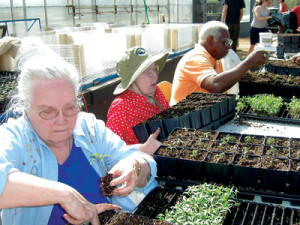 In another situation, a violence-prone teen found himself relating to others in the garden in a good way. “It gave him the chance to see himself in a positive way, as someone who is valuable and trusted by others,” Haller says.
Boulder’s Growing Gardens supports a number of nonprofit therapeutic gardening programs. The organization gets younger kids involved in gardening by sponsoring workshops with local chefs. The chefs demonstrate ways to serve up favorite (and not so favorite) vegetables that the kids learn about in the Children’s Peace Garden in north Boulder’s community gardens. “They not only feel the delight of gardening, but it teaches them great eating habits, and healthy eating makes for healthy bodies and minds,” says executive director Ramona Clark.
Teens who participate in Growing Gardens’ ¡Cultiva! Project grow and sell their own produce at the Farmers’ Market. “After each market, the kids collect the remaining fruits and vegetables from the booths and take it to shelters. It’s a great way to build self-esteem, and to connect with the community,” Clark says.
In another situation, a violence-prone teen found himself relating to others in the garden in a good way. “It gave him the chance to see himself in a positive way, as someone who is valuable and trusted by others,” Haller says.
Boulder’s Growing Gardens supports a number of nonprofit therapeutic gardening programs. The organization gets younger kids involved in gardening by sponsoring workshops with local chefs. The chefs demonstrate ways to serve up favorite (and not so favorite) vegetables that the kids learn about in the Children’s Peace Garden in north Boulder’s community gardens. “They not only feel the delight of gardening, but it teaches them great eating habits, and healthy eating makes for healthy bodies and minds,” says executive director Ramona Clark.
Teens who participate in Growing Gardens’ ¡Cultiva! Project grow and sell their own produce at the Farmers’ Market. “After each market, the kids collect the remaining fruits and vegetables from the booths and take it to shelters. It’s a great way to build self-esteem, and to connect with the community,” Clark says.
Roll with the Curves
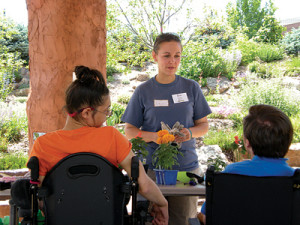 Horticultural therapy applications are varied, but Jay Stone Rice, Ph.D., a San Rafael, Calif., psychotherapist and HTI faculty member, sees a common thread that explains these programs’ success. “When life throws us a curve, we tend to feel like it came from out of nowhere. We ask ourselves, ‘Why me?’” he says. “But working with nature shows us that curves are an ordinary part of living. A plant will adjust to find the right light or adapt to seasons of drought. We pass through cycles, too. Gardening teaches us to let go, to let things die, and to embrace the new things that come along.”
Horticultural therapy is highly effective for people with catastrophic injuries, as well as those who suffer with depression, he says. “Often people with depression don’t have much energy,” Rice explains. “The great thing about gardening is that even the smallest effort can yield beautiful results.”
Horticultural therapy applications are varied, but Jay Stone Rice, Ph.D., a San Rafael, Calif., psychotherapist and HTI faculty member, sees a common thread that explains these programs’ success. “When life throws us a curve, we tend to feel like it came from out of nowhere. We ask ourselves, ‘Why me?’” he says. “But working with nature shows us that curves are an ordinary part of living. A plant will adjust to find the right light or adapt to seasons of drought. We pass through cycles, too. Gardening teaches us to let go, to let things die, and to embrace the new things that come along.”
Horticultural therapy is highly effective for people with catastrophic injuries, as well as those who suffer with depression, he says. “Often people with depression don’t have much energy,” Rice explains. “The great thing about gardening is that even the smallest effort can yield beautiful results.”
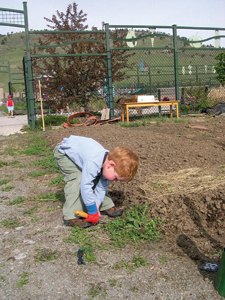 In fact, activity plays a significant role in horticultural therapy. Caring for and nurturing a plant imparts responsibility and a sense of hope. But for some, those activities start to feel like chores. The way we interact with our own gardens often is a model of how we live our lives and handle our other relationships. “Sometimes people try to dominate the garden, to control it,” Rice says. “Your garden should shape your vision—not the other way around. Sure, we can guide and organize it, but then we need to step back and let it be what it will be.”
If your garden is taking you to task, you may need an attitude adjustment. “We tend to tune out when we work, and that is a missed opportunity for growth,” Rice explains. “While you garden, stay engaged and reflect on the analogy of nature. For instance, as you deadhead or remove debris, consider what needs to be released in your own life.”
A therapeutic garden should be tailored to an individual’s needs. Yet, some tried-and-true plants appear to work universally. Native plants, for example, are a model for adaptability. By no coincidence, they tend to be easy keepers and attract birds and butterflies. Heirlooms, like hollyhocks and roses, offer nostalgia and time-tested beauty. Many horticultural therapy programs emphasize edibles, especially tomatoes. Watching seeds grow also offers a great, full-cycle experience. “You can balance seeds with the immediate gratification of bedding plants or perennials,” Haller suggests. She also likes to use plants with comforting or fun names: “Kids love snapdragons!”
Landscape designer Preston Whitfield, a certified landscape technician and co-owner of A Natural Bliss in Longmont, credits his early horticultural-therapy training for his desire to create “healing gardens.” Whitfield was inspired by how dementia patients “went from lifeless to engaging in the garden” through horticultural therapy. So he took the technique a step further and now employs naturopaths at his company who choose medicinal plants for clients’ gardens that can be made into tinctures or salves to treat ailments. While any garden can be therapeutic, Whitfield notes, a healing garden is meant to do just that: heal.
In fact, activity plays a significant role in horticultural therapy. Caring for and nurturing a plant imparts responsibility and a sense of hope. But for some, those activities start to feel like chores. The way we interact with our own gardens often is a model of how we live our lives and handle our other relationships. “Sometimes people try to dominate the garden, to control it,” Rice says. “Your garden should shape your vision—not the other way around. Sure, we can guide and organize it, but then we need to step back and let it be what it will be.”
If your garden is taking you to task, you may need an attitude adjustment. “We tend to tune out when we work, and that is a missed opportunity for growth,” Rice explains. “While you garden, stay engaged and reflect on the analogy of nature. For instance, as you deadhead or remove debris, consider what needs to be released in your own life.”
A therapeutic garden should be tailored to an individual’s needs. Yet, some tried-and-true plants appear to work universally. Native plants, for example, are a model for adaptability. By no coincidence, they tend to be easy keepers and attract birds and butterflies. Heirlooms, like hollyhocks and roses, offer nostalgia and time-tested beauty. Many horticultural therapy programs emphasize edibles, especially tomatoes. Watching seeds grow also offers a great, full-cycle experience. “You can balance seeds with the immediate gratification of bedding plants or perennials,” Haller suggests. She also likes to use plants with comforting or fun names: “Kids love snapdragons!”
Landscape designer Preston Whitfield, a certified landscape technician and co-owner of A Natural Bliss in Longmont, credits his early horticultural-therapy training for his desire to create “healing gardens.” Whitfield was inspired by how dementia patients “went from lifeless to engaging in the garden” through horticultural therapy. So he took the technique a step further and now employs naturopaths at his company who choose medicinal plants for clients’ gardens that can be made into tinctures or salves to treat ailments. While any garden can be therapeutic, Whitfield notes, a healing garden is meant to do just that: heal.
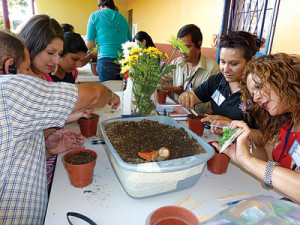 The key to making a garden therapeutic, according to Whitfield, is to engage each of the senses. He suggests plants of contrasting colors, heights and textures for the eyes; rustling plants like aspens or pines for the ears; perfumed plants like roses, lilacs and honeysuckles for the nose; soft touches like lambs’ ears or mullein for the hands; and fruit trees, herbs and other edibles for the palate. “The more the garden pulls you out of the daily grind, the deeper you move into the present, where you can heal and feel restored,” he says.
So the next time you stick a plant in the ground, remember you’re not just sprucing up the landscape. You’re rooting a new relationship.
The key to making a garden therapeutic, according to Whitfield, is to engage each of the senses. He suggests plants of contrasting colors, heights and textures for the eyes; rustling plants like aspens or pines for the ears; perfumed plants like roses, lilacs and honeysuckles for the nose; soft touches like lambs’ ears or mullein for the hands; and fruit trees, herbs and other edibles for the palate. “The more the garden pulls you out of the daily grind, the deeper you move into the present, where you can heal and feel restored,” he says.
So the next time you stick a plant in the ground, remember you’re not just sprucing up the landscape. You’re rooting a new relationship.

